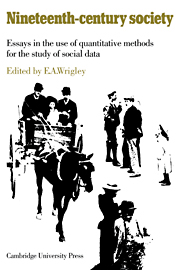Book contents
- Frontmatter
- Contributors
- Contents
- Introduction
- 1 The census, 1801–1891
- 2 The study of family structure
- 3 Sources of inaccuracy in the 1851 and 1861 censuses
- 4 Standard tabulation procedures for the census enumerators' books 1851–1891
- 5 Sampling in historical research
- 6 The use of information about occupation
- 7 The use of published census data in migration studies
- 8 Criminal statistics and their interpretation
- 9 The incidence of education in mid-century
- Notes
- Bibliography
- Index
7 - The use of published census data in migration studies
Published online by Cambridge University Press: 05 November 2011
- Frontmatter
- Contributors
- Contents
- Introduction
- 1 The census, 1801–1891
- 2 The study of family structure
- 3 Sources of inaccuracy in the 1851 and 1861 censuses
- 4 Standard tabulation procedures for the census enumerators' books 1851–1891
- 5 Sampling in historical research
- 6 The use of information about occupation
- 7 The use of published census data in migration studies
- 8 Criminal statistics and their interpretation
- 9 The incidence of education in mid-century
- Notes
- Bibliography
- Index
Summary
INTRODUCTION
A basic problem of social history is quantifying the available evidence. This is particularly true of migration studies. There is, of course, a great deal of statistical material available for the later nineteenth century but its handling has frequently masked many interesting features. For example, estimates of net intercensal migration are inherently highly accurate and commonly appear in modern census tables. But they are of much less use to a student of social change than the far less accurate estimation of flows of migrants. That is, a ‘snapshot’ of the effect of migration upon the population growth of an area will tell us little about the process of migration because the bulk of movement is complemented by flows in the opposite direction. Lancashire, for instance, was a net receiver of migrants throughout the nineteenth century and in fact gained 205,000 persons net in the 1870s. But the county lost (by the author's grossly understated estimation) at least 75,000 Lancastrians in the same period. Methods for estimating ‘native’ and ‘net’ outflows are discussed in section 3 below. Similarly, simple statements of the places of origin (the birthplaces) of a migrant Group are of little value unless the recent migrants – those who moved that decade – are distinguished.
THE NATURE OF THE EVIDENCE
The two main sources for the type of study described here are the ‘birthplaces of the people’, published in the census tables which give the county of birth, and the annual reports of the Registrar-General.
- Type
- Chapter
- Information
- Nineteenth Century Society , pp. 311 - 335Publisher: Cambridge University PressPrint publication year: 1972
- 4
- Cited by



